Matt Nagy's Offense is full of these "shot plays". It is his personality to attack down the field and stress defenses vertically. One of my favorite examples of this is his double move off of the scissors concept. Three of the variations that Nagy used in 2018 are drawn below.
This concept has a lot of flexibility. It can be a tag off of your base version of scissors, or you can max protect and insulate your quarterback better against a blitz. The neat part about the concept is that you do not necessarily have to major in the scissors concept for it to be effective. With the route stems looking nearly identical to the flood concept (one of the most commonly used concepts in America), you can treat that as the base look for the double move.
This double move can be quite potent against any coverage. Lets take a look at some video examples, in order of the diagrams above:
The pre-snap motion from Allen Robinson shows that the Packers will most likely be in an off-man coverage. After the ball is snapped we see that this is the case. Robinson, a tremendous route runner on a weekly basis, runs a smooth double move and keeps the defender in a trail position. With a little better protection and a little more pocket patience from the young Trubisky, the Bears were looking at 6 points.
The next video shows the play that corresponds to the second diagram from above.
This play is very similar tot he first example, but with a flat control route from the running back. Max protection will theoretically buy the quarterback the extra second he needs to get the ball off on the double move. Both Trubisky and the rolled-down safety slip on the notoriously slick Soldier Field turf. Great route from Burton to create separation and panic, leading tot he slip.
The last video shows the concept in the third diagram, out of a trips formation with an exchange of routes from the #2 and #3 receiver.
This play variation is another way to get to the same concept. Here, Nagy runs the double move with Cohen at the #3 spot in trips. The offensive staff for the Bears made a clear effort in 2018 to get Cohen favorable matchups in the pass game, and this is an example of creating an explosive attempt in that context.
Connecting on these explosive plays early on against Tampa Bay really took the visiting team out of the game mentally. Explosive plays can have this effect on teams. We are all humans with emotions (well, most of us).
The chart below shows the overall efficiency for the concept in 2018.
Nagy had a second double move off the scissors concept that also created open explosive play opportunities for the Bears in 2018. You can find this concept diagrammed and discussed in the 2018 Bears Offensive Manual, found on Amazon. The book details Nagy's entire offense in 280 pages. Click Here to get your copy today



